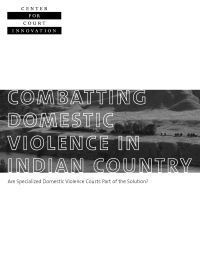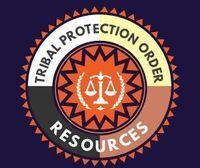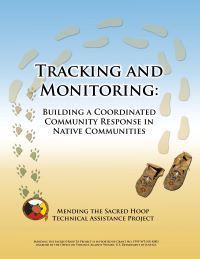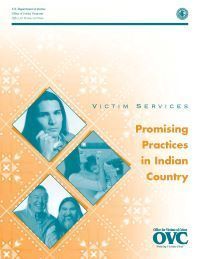This page contains materials and resource for legal and law enforcement professional working with indigenous peoples and communities.
This page contains best practices, materials, and resources for legal and law enforcement allies.
-
In this webinar, the National Congress of American Indians Task Force on Violence Against Women will provide an update on efforts to remove barriers preventing American Indian tribes and Alaska Native villages from accessing the Crime Victim Fund. Unlike state and territorial governments, tribal governments do not receive an annual allocation from the Crime Victims Fund to help crime victims in their communities.
-
Domestic violence is one of the most pressing problems facing Native American and Alaska Native communities. Although the reauthorized Violence Against Women Act recognizes the authority of tribes to prosecute non-Native offenders, more tools are needed. This paper explores whether specialized domestic violence courts, which focus on enhancing victim safety and promoting offender accountability, can be part of a multi-faceted approach for tribal justice systems to address domestic violence.
-
Advocates consider many legal factors when addressing domestic violence and sexual assault in Indigenous Nations/Territories.
This page contains information on Tribal Protection Order Resources: an Online Resource for Drafting and Enforcing Tribal Protection Orders.
-
A general introduction to the social and legal issues involved in acts of violence against Native women, this book's contributors are lawyers, social workers, social scientists, writers, poets, and victims. In the U.S. Native women are more likely than women from any other group to suffer violence, from rape and battery to more subtle forms of abuse, and Sharing Our Stories of Survival explores the causes and consequences of such behavior. The stories and case-studies presented here are often painful and raw, and the statistics are overwhelmingly grim; but a countervailing theme also runs through this extremely informative volume: Many of the women who appear in these pages are survivors, often strengthened by their travails, and the violence examined here is human violence, meaning that it can be changed, if only with much effort and education. The first step is to lay out the truth for all to see, and that is the purpose accomplished by this book.
-
Strangulation has been identified as one of the most lethal forms of domestic violence and sexual assault. This session will examine the mechanics of strangulation and suffocation from a legal and law enforcement perspective.
-
This manual was created to specifically outline the process of building a Coordinated Community Response (CCR) in Native communities. A CCR, simply stated, is a monitoring and tracking system that establishes women’s safety by focusing on batterers and their activity. This is done through a multi-agency collaboration with individuals dedicated to developing a response to domestic violence by implementing policies and practices to ensure batterer accountability. Each agency develops a role within this collaboration, ensuring a consistent response from law enforcement, prosecutors, judges and probation officers. The many complex jurisdictional and legal issues that exist in Indian country make it difficult to pose a single organizing model that is relevant to all Native communities. This manual separates the creation of building a Coordinated Community Response into a framework for general use, suggesting ways to customize this practice to suit the needs of diverse communities.
-
This monograph describes promising practices for meeting the needs of victims of violence and domestic and family abuse in Indian Country. Each of the 12 program summaries includes a description of the program's activities, keys to its success, basic demographic data (e.g., service area and population), and contact information.
-
This guide contains information on protection orders and Native American women and domestic and sexual violence. It provides specific information on the barriers to justice faced by Native women and tribal communities. The guide contains guidance for practitioners and discipline-specific resources.









